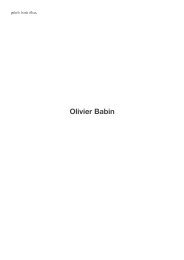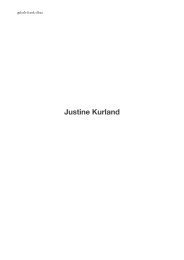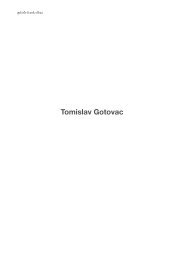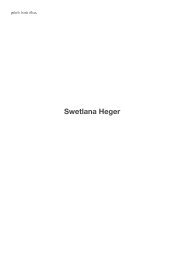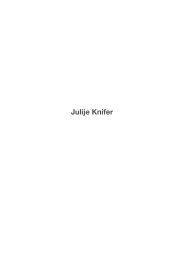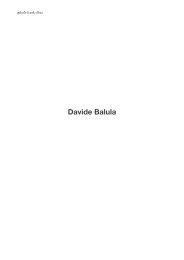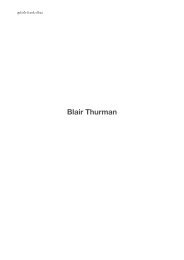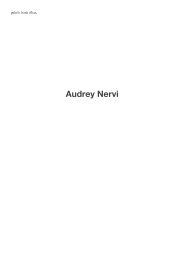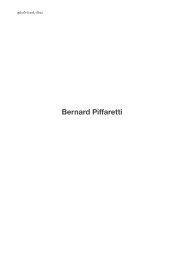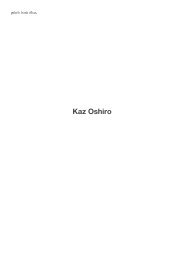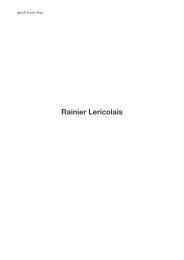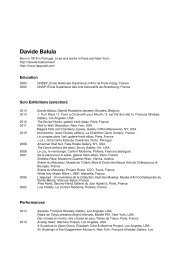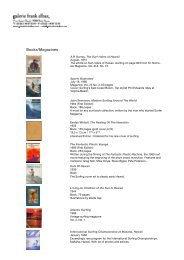Gyan Panchal - Galerie Frank Elbaz
Gyan Panchal - Galerie Frank Elbaz
Gyan Panchal - Galerie Frank Elbaz
Create successful ePaper yourself
Turn your PDF publications into a flip-book with our unique Google optimized e-Paper software.
<strong>Gyan</strong> <strong>Panchal</strong>Baubajai, 2012, Carton mousse, poudre de sanguine, Dimensions variables (3 éléments)Baubajai, 2012, Foamboard, sanguine powder, Variable dimensions (3 elements)
<strong>Gyan</strong> <strong>Panchal</strong>Oncn, 2012, Polystyrène, polyuréthane, poudre de marbre, 106 x 26,5 x 12 cm, Pièce uniqueOncn, 2012, Olystyrene, polyurethane, marble powder, 41,7 x 10,4 x 4,7 inches, Unique
<strong>Gyan</strong> <strong>Panchal</strong>Qomde, 2012, Polystyrène extrudé, filasse de sisal, Environ 240 x 60 cm, Pièce uniqueQomde, 2012, Extruded polystyrene, sisal, Approximately 94,5 x 23,5 in., Unique
<strong>Gyan</strong> <strong>Panchal</strong>Drkta, 2012, Aluminium, blanc de titane, jaune cadmium, 207 x 8 cm, Pièce uniqueDrkta, 2012, Aluminium, Titanium white, Cadmium yellow, 81,5 x 3 in., Unique
<strong>Gyan</strong> <strong>Panchal</strong>Drdrajo, 2011, Plastique recyclé, 35 x 79 cm, Pièce uniqueDrdrajo, 2011, Recycled plastic, 13,5 x 31 in., Unique
<strong>Gyan</strong> <strong>Panchal</strong>sans titre, 2012, Marbre, encre, 69 x 58 x 1,5 cm, Pièce uniquesans titre, 2012, Marble, ink, 27 x 22¾ x 0,5 in., Unique
<strong>Gyan</strong> <strong>Panchal</strong>sans titre, 2012, Écorce de palmier, peinture, papier, 220 x 50 x 24 cm, Pièce uniquesans titre, 2012, Bark of a palm tree, paint, paper, 86½ x 19½ x 9½ in., Unique
<strong>Gyan</strong> <strong>Panchal</strong>sans titre, 2011, Sari traditionnel rigidifié par un liant puis froissé, 800 x 120 cm, Pièce uniqueuntitled, 2011, Traditional Sari stiffened by a binder and then crushed, 315 x 47¼ in., UniqueVue de l’exposition Paris - Dehli - Bombay, Centre Georges Pompidou, Paris, France, 2011View of the exhibition Paris - Dehli - Bombay, Centre Georges Pompidou, Paris, France, 2011
<strong>Gyan</strong> <strong>Panchal</strong>dhrso, 2011, Carton mousse, Bitume de Judée, 300 x 100 x 1 cm (chaque élément), Pièce uniquedhrso, 2011, Foam board, Bitumen of Judea, 118 x 39,37 x 0,39 cm in., Unique
<strong>Gyan</strong> <strong>Panchal</strong>sans titre, 2010, Polystyrène extrudé, argile, 130 x 125 x 60 cm, Pièce uniqueuntitled, 2010, Extruded polystyrene, clay, 51 1/3 x 49 1/3 x 23 1/2 in., Unique
<strong>Gyan</strong> <strong>Panchal</strong>sans titre, 2010, cire d’abeille, fibre de verre, 32,5 x 26,5 cm, Pièce uniqueuntitled, 2010, Beeswax, fibreglass, 12 3/4 x 10 1/2 in., Unique
<strong>Gyan</strong> <strong>Panchal</strong>ausijo, 2009, Polystyrène expansé, pétrole, 230 x 100 x 10 cm, Pièce uniqueausijo, 2009, Expanded polystyrene, crude oil, 90 1/2 x 39 1/3 x 4 in., Unique
<strong>Gyan</strong> <strong>Panchal</strong>kenes, 2009, Polypropylène, curcuma, 100 x 80 cm, Pièce uniquekenes, 2009, Polypropylene, turmeric, 39 1/3 x 31 1/2 in., Unique
<strong>Gyan</strong> <strong>Panchal</strong>tersomoi, 2009, Carton plume, 200 x 140 cm, Pièce uniquetersomoi, 2009, Foam board, 78 3/4 x 55 1/3 in., Unique
<strong>Gyan</strong> <strong>Panchal</strong>aitis 1, 2009, Polystyrène expansé, 117 x 122 x 60 cm, Pièce uniqueaitis 1, 2009, Expanded polystyrene, 46 x 48 x 23 1/2 in., Unique
<strong>Gyan</strong> <strong>Panchal</strong>qqlos 2, 2009, Polystyrène expansé, 230 x 220 x 60 cm, Pièce uniqueqqlos 2, 2009, Expanded polystyrene, 90 1/2 x 86 1/2 x 23 1/2 in., UniqueVue de l’exposition “brick says: I like an arch”, Le SPOT, Le Havre, France, 2009View of the exhibition “brick says: I like an arch”, Le SPOT, Le Havre, France, 2009© le SPOT, Le HavrePhoto : André Morin, Paris
<strong>Gyan</strong> <strong>Panchal</strong>ptomn, 2009, Polyéthylène, Dimensions variables, Pièce uniqueptomn, 2009, Polyethylene, Variable dimensions, UniqueVue de l’exposition “brick says: I like an arch”, Le SPOT, Le Havre, France, 2009View of the exhibition “brick says: I like an arch”, Le SPOT, Le Havre, France, 2009© le SPOT, Le HavrePhoto : André Morin, Paris
<strong>Gyan</strong> <strong>Panchal</strong>uoel, 2006-2008, Polystyrène expansé, pétrole brut, 60 x 120 x 250 cmPièce uniqueuoel, 2006-2008, Expansed polystyrene, crude oil, 23 1/2 x 47 1/3 x 98 1/3 in., UniqueVue de l’exposition La Consistance du visible,View of the exhibition La Consistance du visible,Fondation d’entreprise Ricard, Paris, 2008,curated by Nicolas BourriaudPhoto : Marc Domage
<strong>Gyan</strong> <strong>Panchal</strong>laste, 2006, Polyéthylène, laque, 2 éléments: 120 x 80 cm chaquePièce uniquelaste, 2006, Polyethylene, lacquer, 2 elements: 47 1/3 x 31 1/2 in. each, Unique
<strong>Gyan</strong> <strong>Panchal</strong>eca, 2005, Polystyrène expansé, 60 x 120 x 250 cm chaque (2 éléments), Pièce uniqueeca, 2005, Expansed polystyrene, 2 elements: 23 1/2 x 47 1/3 x 98 1/3 in. each (2 elements), Unique
Exhibition views
66 rue de Turenne – 75003 Paris, FranceTél. +33 (0)1 48 87 50 04info@galeriefrankelbaz.comwww.galeriefrankelbaz.com<strong>Gyan</strong> <strong>Panchal</strong>Ce lien qui nous sépareExposition du 8 septembre au 13 octobre 2012Du mardi au samedi 11h-19hVernissage le samedi 8 septembreUne des clefs de l’œuvre de <strong>Gyan</strong> <strong>Panchal</strong> serait-elle de l’imaginer dans le monde extérieur ? Imaginer sa nature d’objet trouvé non pas aumoment où il devient objet d’art, mais après qu’il le soit devenu. Envisager que son œuvre, ou du moins certains aspects de son œuvre, nedeviennent pas de l’art. Que les matériaux trouvés, récupérés, transformés a minima, avec lesquels <strong>Panchal</strong> travaille, conservent leur étatpremier, irréductible, exact. Ou, pour exprimer le problème autrement, qu’en serait-il s’il ne s’agissait pas d’art ? si les matériaux n’avaientjamais été touchés par la main de l’artiste et ainsi transformés ? S’il s’agissait de quelque chose d’autre : une chose plus sujette à la découverteà défaut d’être plus primitive, et appréciée avec davantage de profondeur et d’étonnement, pour ce qu’elle est réellement ? Qu’est-ceque je veux dire par là ? (En effet, y a-t-il une chose plus à même d’être découverte que l’art ? Autre que les découvertes qu’il permet deréaliser à son tour ?)Imaginons un instant un bricoleur qui, assis dans son garage, prend soudain conscience du monde matériel qui l’entoure, dans toute sarichesse et sa diversité. Quelqu’un qui verrait comme pour la première fois des couleurs ou des éléments tels que la feuille d’argent, le jaunecadmium, le blanc de titane, le sisal, le papier isolant, l’aluminium, le polyuréthane ou le polystyrène, matériaux qui font tous partie des dernierstravaux de <strong>Panchal</strong>. Frappé de les découvrir d’une telle manière, il serait poussé à essayer de les comprendre, pas forcément en destermes scientifiques ou symboliques, mais sur un plan plus immédiatement physique, plus tactile, comme si leur secret ou, mieux encore,leur vérité, était dissimulée dans l’épaisseur même de leur texture, juste sous la surface, dans leurs fibres, dans leur existence matérielle.Poursuivons un instant notre scénario fictif et ajoutons que notre bricoleur (personnage quelque peu beckettien, inévitablement. — Inévitablement? — Comment pourrait-il en être autrement d’un homme solitaire qui traite des matériaux artificiels comme s’il s’agissait de formesnaturelles, de substituts plausibles de la nature ?), comme la plupart des bricoleurs, est un être légèrement décalé, sujet à des accès defantaisie qui frôlent la paranoïa. Fasciné par les découvertes qu’il a faites, il commence à y percevoir une forme d’excès dont il ne peut pasrendre compte, mais qui néanmoins commencerait à rendre compte de lui-même, d’une manière ou d’une autre. C’est presque comme sices matériaux se mettaient à exister par eux-mêmes, devenaient des êtres vivants, des individus, de la manière la plus discrète mais en mêmetemps la plus troublante (ce qui pourrait bien être le cas).On pourrait voir ressurgir à cet instant la vilaine allégorie. Mais pour qu’une allégorie prenne forme, il faudrait nécessairement que les matériauxse mettent au service d’autre chose, fonctionnent comme un moyen pour parvenir à une fin, plutôt que de représenter des fins eneux-mêmes, ce qui est précisément le cas chez <strong>Panchal</strong>. On pourrait dire que l’artiste, en affinant les qualités essentielles de ces matériaux,en habille la nudité avant de les retourner au monde dans l’ampleur de leur contradiction naturelle, aussi austères qu’excessifs, aussi précisqu’ils sont, en fin de compte, opulents.Chris Sharp(traduction de Gabriel Baldessin)Né en 1973 en France. Vit et travaille à Paris, France.Expositions (sélection): 2012 : Shanghai Bienniale, Mumbai Pavilion, Shanghai (D. Campbell, S. Hapgood); Les Prairies, Biennale d’art contemporain, Rennes(A. Bonnin); Archéologies contemporaines, Musée du château des ducs de Wurtemberg, Montbéliard (A. Voltz); Jhaveri Contemporary, Mumbai (solo); 2011: Pour un art pauvre, Carré d’Art – Musée d’art contemporain, Nîmes (F. Cohen); Paris-Delhi-Bombay…, Centre Pompidou, Paris (F. Bousteau et S. Duplaix);2009 : « the brick says : I like an arch », Le SPOT, Le Havre (solo); 2008 : Cairn, Module Palais de Tokyo, Paris (solo); <strong>Galerie</strong> Edouard Manet, Gennevilliers; LaConsistance du visible, Fondation d’Entreprise Ricard, Paris.Dossier de presse disponible, contacter Daphné : 01 48 87 50 04 ou daphne@galeriefrankelbaz.com
66 rue de Turenne – 75003 Paris, FranceTél. +33 (0)1 48 87 50 04info@galeriefrankelbaz.comwww.galeriefrankelbaz.com<strong>Gyan</strong> <strong>Panchal</strong>This bond that separates usExhibition from September 8th to October 13th, 2012Tuesday-Saturday 11am-7pmOpening on Saturday, September 8thPerhaps one of the secrets of <strong>Gyan</strong> <strong>Panchal</strong>’s work is imagining it out in the world. Imagining its nature as found object not just before itbecomes art, but after it becomes art. Imagining that it, or at least certain aspects of it, may, in fact, never become art. That the found, recuperatedand minimally modified materials with which <strong>Panchal</strong> works are nothing more than exactly and irreducibly themselves. Or to put itanother way, what if this wasn’t art? Was never touched by the hand of an artist and thereby transformed into art? But was something else,something if not more primitive, then more discovered, more weirdly and deeply appreciated for what it is. What do I mean by that? (For whatcould be more discovered than art? Other than the discoveries that it allows you to make?)Imagine, say, a tinkerer sitting in his garage and suddenly growing aware of the rich and manifold material world around him. Seeing, truly,for the first time, such colors and things as silver leaf, cadmium yellow, titanium white, sisal, insulation paper, aluminum, polyurethane, andstyrofoam (all the materials of which <strong>Panchal</strong>’s latest production is composed). Noticing them thus, he becomes compelled to understandthem, not necessarily in scientific or symbolic terms, but in more immediate physical and tactile terms, as if their secret, or better yet, theirtruth, could be found within their texture, or just beneath their surface, in their fibers, in their material being.For the sake of pursuing this fictive scenario, let us acknowledge that our tinkerer (inevitably, a somewhat Beckettian figure. Inevitably? Solitaryand treating artificial materials as if they were a kind of nature, a plausible substitute for it, how could he not be?), like most tinkerers, is slightlyunhinged and given to flights of somewhat paranoid fancy. Bewitched by the discoveries he has made, he begins to perceive in them a kindof excess for which he cannot account, but which nevertheless begins in some way to account for him. It is almost as if these materials assumeda life, so to speak, of their own, became beings, individuals in the most understated, yet uncanny way (which might well be the case).Here, allegory could be said to begin to rear its ugly head. But in order for any real allegory to happen, these materials would have to be inthe service of something else, functioning as a means to an end, as opposed to ends in themselves, which is what they become in <strong>Panchal</strong>’swork. Honing in on their essential qualities, <strong>Panchal</strong> could be said to dress their nudity before giving them back to the world in the fullness oftheir natural contradiction, as austere as they are excessive and precise as they are ultimately opulent.Chris SharpBorn in 1973 in France. Lives and works in Paris, France.Exhibitions (selection): 2012 : Shanghai Bienniale, Mumbai Pavilion, Shanghai (D. Campbell, S. Hapgood); Les Prairies, Biennale d’art contemporain, Rennes(A. Bonnin); Archéologies contemporaines, Musée du château des ducs de Wurtemberg, Montbéliard (A. Voltz); Jhaveri Contemporary, Mumbai (solo); 2011: Pour un art pauvre, Carré d’Art – Musée d’art contemporain, Nîmes (F. Cohen); Paris-Delhi-Bombay…, Centre Pompidou, Paris (F. Bousteau et S. Duplaix);2009 : « the brick says : I like an arch », Le SPOT, Le Havre (solo); 2008 : Cairn, Module Palais de Tokyo, Paris (solo); <strong>Galerie</strong> Edouard Manet, Gennevilliers; LaConsistance du visible, Fondation d’Entreprise Ricard, Paris.Press file available on demand, please contact Daphné : 01 48 87 50 04 or daphne@galeriefrankelbaz.com
<strong>Gyan</strong> <strong>Panchal</strong>Vue de l’exposition Ce lien qui nous sépare, galerie frank elbaz, Paris, France, 2012View of the exhibition This bond that separates us, galerie frank elbaz, Paris, France, 2012
<strong>Gyan</strong> <strong>Panchal</strong>Vue de l’exposition Ce lien qui nous sépare, galerie frank elbaz, Paris, France, 2012View of the exhibition This bond that separates us, galerie frank elbaz, Paris, France, 2012
<strong>Gyan</strong> <strong>Panchal</strong>Vue de l’exposition Ce lien qui nous sépare, galerie frank elbaz, Paris, France, 2012View of the exhibition This bond that separates us, galerie frank elbaz, Paris, France, 2012
<strong>Gyan</strong> <strong>Panchal</strong>Vue de l’exposition Ce lien qui nous sépare, galerie frank elbaz, Paris, France, 2012View of the exhibition This bond that separates us, galerie frank elbaz, Paris, France, 2012
<strong>Gyan</strong> <strong>Panchal</strong>Vue de l’exposition Pour un art pauvre (inventaire du monde et de l’atelier), Carré d’art - Musée d’art contemporain,Nîmes, France, 2011View of the exhibition Pour un art pauvre (inventaire du monde et de l’atelier), Carré d’art - Musée d’art contemporain,Nîmes, France, 2011
<strong>Gyan</strong> <strong>Panchal</strong>Vue de l’exposition “brick says: I like an arch”, le SPOT, Le Havre, France, 2009View of the exhibition “brick says: I like an arch”, le SPOT, Le Havre, France, 2009© le SPOT, Le HavrePhoto : André Morin, Paris
<strong>Gyan</strong> <strong>Panchal</strong>Vue de l’exposition “brick says: I like an arch”, le SPOT, Le Havre, France, 2009View of the exhibition “brick says: I like an arch”, le SPOT, Le Havre, France, 2009© le SPOT, Le HavrePhoto : André Morin, Paris
Texts
<strong>Gyan</strong> <strong>Panchal</strong>Je fais de la sculpture comme une façon de demander au matériau s’il porte encoreles traces de sa propre histoire. Quel sorte de lien y a-t-il entre un tissu synthétiqueet un pigment naturel ? Que puis-je construire à partir de cette parenté abstraite ?Je considère la sculpture comme une question irrésolue. En confrontant le matériauà son origine et à sa fabrication, je réfléchis à la relation que nous entretenons avecces matériaux muets qui composent notre environnement.Je pense à une sculpture presque accidentelle, faite d’échecs et de choix. Quelquechose qui ne tient peut-être pas debout par elle-même, qui ne peut rien affirmer. Unobjet abstrait en apparence, encore indéterminé, comme une tentative dematérialiser et de définir celui-ci. Un objet qui reste précaire et nécessairementinsuffisant. Je pense à une sculpture distante et irréconciliée – une sculpture quidéserte.I’m making sculpture as a way of asking the material if it still bears the traces of itsown story. What kind of link is there between a synthetic fabric and a naturalpigment ? What can I construct out of their abstract relationship ? I see sculpture asan unresolved question. By confronting the material with its origin and its making, Ireflect on our relationship with the mute materials that compose today’senvironment.I think of a sculpture almost done by accident, made of failures and choices. Something that maybe doesn’t stand up by itself, that cannot state anything. Anapparently abstract object, still indeterminate, but an attempt to materialize and todefine it. An object that remains precarious and necessarily insufficient. I’m thinkingof a distant and irreconcilable sculpture – a deserting sculpture.
Zehra Jumabhoy, “<strong>Gyan</strong> <strong>Panchal</strong>”, in ARTFORUM, April 2012
Deepanjana Pal, “<strong>Gyan</strong> <strong>Panchal</strong>”, in Frieze Magazine, April 2012
Emmanuelle Lequeux, “Les riches idées de l”art pauvre” ”, in le monde, décembre 2011
Bénédicte Ramade, “<strong>Gyan</strong> <strong>Panchal</strong> du bon usage de la pauvreté”, in l’oeil, décembre 2011
Emmanuelle Lequeux, “<strong>Gyan</strong> <strong>Panchal</strong> l’alchimiste conceptuel”, in Le Monde 2, semaine du 26mai 2011
Coline Milliard “Gestes plastiques” in www.cataloguemagazine.com, July 2010
pp. 395-396



